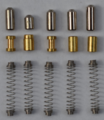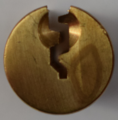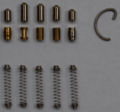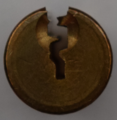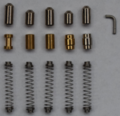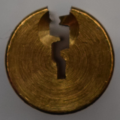FAB 200
FAB 200
| FAB 200 | |
 | |
| Name | FAB 200 |
|---|---|
| Manufacturer | FAB |
| Lock Type | Cylinder |
| Lock Design | Pin-tumbler |
| Patent | CZ303220B6 |
| Specifications | |
| # of Components | 5 |
| Component Type | Pin-tumbler |
FAB 200 is a line of pin-tumbler lock cylinders belonging to a resistance class 3 (according to CSN P EN1627:2000). It is recommended to secure front doors of flats, houses and offices. The original FAB 200 line was superseded by the FAB 200RS line, which used new key blanks. The FAB 200RS evolved into FAB 200RSG line, which added some security features (mainly core pulling protection), but due to more time consuming and tedious maintenance it faced big pushback from the locksmithing community. The FAB 200RSG line is now discontinued and FAB 200RSB is sold instead, offering increased anti-drill protection.
The FAB 200 line is the first, offering the protection against the unauthorized copying of the key; locksmith will cut/copy a key only when presented with the security card.
FAB 200
Description
The lock contains five pin stacks, with two stacks containing standard drivers and two stacks containing spools, and there is one RBC pin (note the older RBC pin style).
The profile used is mildly paracentric, but doesn't add much to the protection against lockpicking.
Note the key is using the usual shoulder stop.
Disassembly instructions
To disassemble a double euro cylinder, use of a pinning shoe is the preferred method.
Other possibility is to use a segmented follower, but that requires that both cores are pulled out a bit to allow a cam removal. Then a core should be rotated to approximately 4:30 or 7:30 o'clock position (135 degrees either clockwise or anti-clockwise) to prevent driver entering a gaps for the cam clutch. Then a segmented follower can be used to remove the core.
Gallery
FAB 200RS
Description
The main difference of the FAB 200RS line is the use of a shoulderless key, with a notch in its nose; this notch interacts with a steel wire insert in the core and prevents the key from entering too deep.
The lock contains five pin stacks, with two stacks containing the standard drivers, two stacks containing RBC pins, and there is a single spool. This hints that the dynamic methods are perceived as a bigger threat than classical picking (although the RBC pins can frustrate picking as well).
The profile used is mildly paracentric, but in combination with well placed RBC pins, can make picking a problem.
Dissassembly instructions
Due to the RS element presence, use of a pinning shoe is no longer an option.
Segmented follower has to be used, but that requires that both cores are pulled out a bit to allow a cam removal. Then a core should be rotated to approximately 4:30 or 7:30 o'clock position (135 degrees either clockwise or anti-clockwise) to prevent driver entering a gaps for the cam clutch. Then a segmented follower can be used to remove the core.
Gallery
FAB 200RSG
Description
The most visible difference of the FAB 200RSG line is the use of a new key, designed in such a way, that it can be used in FAB 200RS locks, but not vice versa. The core doesn't contain the RS wire element, but it has a steel insert (crimped in), which interacts with the key's spine; if a usual RS key is inserted, the insert will catch the nose and prevents full insertion of the key. The RSG key has the front part of its spine removed (up to the notch) and this acts as a stop for the key.
There is also a secondary mechanism preventing use of non RSG keys - the L-shaped wire insert rides in a groove in the lock bible; this groove doesn't have the same depth everywhere, it is deeper on top and shallower towards the bottom. When the RSG key is inserted, the L-shaped element ends in the notch in the key's spine and allows full rotation of the core; when a key without this notch is inserted, the wire will jam in the groove, preventing the core rotation. This mechanism also prevents core removal using the normal RSG key, as the notch is not deep enough to let the wire sink down deep enough to escape from the groove. For disassembly a special "service" key has to be used (it has to be cut to the profile of the original key) and that was a part of the reason why locksmiths dismissed this line of locks (plus often lock had to be send to the manufacturer for repair).
Looking at the key, there is also a cut on its right side, that hints to a possible checkpin, that has to be lifted to a certain height, but nothing that would interact with it is present in the core.
The lock contains five pin stacks, with two chambers containing the standard drivers, two chambers hold RBC pins and there is a single spool. This hints that the dynamic methods are percieved as a bigger threat than classical picking (although the RBC pins can frustrate picking as well).
The profile used is mildly paracentric, but in combination with well placed RBC pins, can make picking a problem.
Dissassembly instructions
Due to the RSG element and the steel core insert, use of a pinning shoe is no longer an option.
When disassembling the lock with a key, the notch in its spine has to be 0.5mm deeper than in a normal RSG key. Then the core has to be rotated 180 degrees and pulled only enough for the wire element to clear the groove. Then the core should be rotated to approximately 4:30 or 7:30 o'clock position (135 degrees either clockwise or anti-clockwise) to prevent driver entering a gaps for the cam clutch. Then a segmented follower can be used to remove the core.
When disassembling the lock without a key, the wire element has to clear the groove to allow the removal of the core. It can be usually achieved by tapping with the lock on a firm surface in such a direction, that the wire is forced by the inertia into the core. Also being in a shallower part of the groove helps, but be careful with application of force when pulling the core out to avoid the rapid disassembly event. When the wire element clears the groove, follow the above directions for the disassembly.
Gallery
FAB 200RSB
Description
After the FAB 200RSG problems, FAB returned back to the RS line, but added the anti-drill protection in the form of two inserts in the bible protecting the pinstacks, two more inserts in the core and also added two steel driver pins. It also seems that FAB reuses (where possible) parts of RSG line locks - this particular lock had a bible that was meant for the FAB 200RSG (has the groove for the wire element).
Dissassembly instructions
Due to the RS element presence, use of a pinning shoe is no longer an option.
Segmented follower has to be used, but that requires that both cores are pulled out a bit to allow a cam removal. Then a core should be rotated to approximately 4:30 or 7:30 o'clock position (135 degrees either clockwise or anti-clockwise) to prevent driver entering a gaps for the cam clutch. Then a segmented follower can be used to remove the core.
Gallery
Vulnerabilities
The FAB 200 is vulnerable to one or more of the following:
- Lockpicking
- Decoding
- Key bumping - when RBC pins are worked around
- Impressioning - provided you can get a proper blank
References
